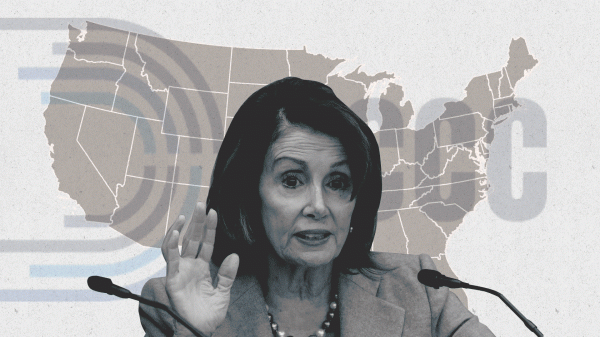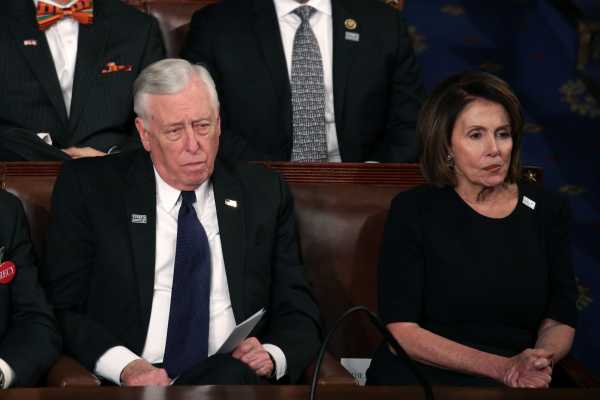 ” alt=”The DCCC’s controversial meddling in 2018 primaries, explained” />
” alt=”The DCCC’s controversial meddling in 2018 primaries, explained” />
The DCCC’s controversial meddling in 2018 primaries, explained
The case for and against national Democrats intervening in primaries.
By
Ella Nilsen
May 3, 2018, 7:00am EDT
Share
Tweet
Share
Share
The DCCC’s controversial meddling in 2018 primaries, explained
tweet
share
House Minority Leader Nancy Pelosi has made it clear she isn’t going to leave a “blue wave” up to chance in 2018.
“I hope for a wave, but I believe you make your wave,” Pelosi said at a February Austin American-Statesman editorial board meeting. “This is a cold-blooded, strategic, focused campaign to win the Congress for the American people. We don’t waste time. We don’t waste energy, we don’t waste resources.”
Stories of Democratic party leadership getting highly involved in primaries around the country keep popping up in 2018. National Democrats asked a Democratic candidate they deemed weak to drop out of the race behind closed doors, and the Democratic Congressional Campaign Committee (DCCC) publicly released opposition research against one Texas Democrat in an attempt to made her candidacy untenable (a move that arguably backfired).
“Obviously it looks bad for the party; they would prefer not to have their fingerprints on this stuff,” said Robert Boatright, a political science professor at Clark University who studies campaigns and primaries. “The smart party strategy is to do this behind the scenes.”
Part of the reason national Democrats want to get involved is that the field of 2018 candidates is enormous. The same enthusiasm that makes a blue wave possible has inspired a record number of Democratic House candidates to enter the fray.
And after surprise wins in Alabama and Pennsylvania special elections, Democrats’ map has grown. Democratic officials worry they could wind up with risky candidates in a year when a lot is on the line. DCCC officials did not respond to a request for comment on this story.
The progressive wing of the party still has PTSD from 2016, when the candidate Democratic Party leaders backed for president sparked furious intraparty debate — and helped land Donald Trump in the White House. And choosing “safe” candidates often means choosing moderate, white Democrats, not bold progressives and fresh faces energizing the left-leaning base.
“I don’t believe we should be anointing candidates,” Democratic National Committee Chair Tom Perez, who is busy trying to mend fences after the 2016 presidential election, said in a C-SPAN Newsmakers interview.
Democratic leadership is readying for a general election campaign — while most candidates are focused on primary season. But will party meddling get the “right” candidate on the general election ballot, or dampen the sky-high enthusiasm Democrats are hoping to ride to a win?
The DCCC is trying to expand the map and split up finite resources
With Trump as president, the stakes for House Democrats could not be higher in 2018. Many pollsters agree the path to flipping the House is easier than the Senate, because numerous House Republicans have retired this year and Democrats are defending a lot of seats in the latter chamber.
The conditions for a House wave election are beginning to form. With Rep. Ben Ray Luján (D-NM) as its chairman, the DCCC has been fundraising at a blistering clip; the organization raised $14.3 million in the month of March alone (nearly $4 million more than the National Republican Campaign Committee) and has raised $140 million so far this cycle, 60 percent of which came from grassroots donations, according to a press release.
Pelosi, a formidable fundraiser in her own right, has smashed her own records. She raised $16.1 million in the first quarter alone, and $66.7 million for the entire cycle — about $1 million more than she did in 2016.
Just as Democratic enthusiasm is translating to cash, it’s also translating to a record number of new candidates — 1,133 were filed by the December deadline alone. Historically, the party has been very good at clearing a path for its preferred candidates; Democratic primaries tend to be far less contentious than Republican ones.
“The DCCC is functioning in a manner that a political organization that wants to be successful functions,” said Colin Strother, a Democratic strategist in Texas who has worked for Rep. Henry Cuellar and others. “Yeah, that means talking people out of races sometimes if we can.”
The DCCC says it has always maintained “the right to get involved” in Democratic primaries in order to field a batch of competitive candidates come November.
“We have been clear all cycle that we reserve the right to get involved in primaries to ensure that there is a competitive Democrat on the ballot in November,” the DCCC’s national press secretary Tyler Law said in a statement to Vox last week.
This glut of 2018 candidates is especially a headache in “jungle primary” states like California, where both parties essentially vie for the top two spots before the general election. Splitting a Democratic field there could risk handing Republicans wins in a state where the GOP is becoming an endangered species.
Democratic officials insist they don’t choose candidates in a vacuum, consulting with local politicians in each state before throwing their weight behind a certain candidate. The candidates the DCCC likes to boost are ones they think can win: candidates with money behind them and political experience.
Picking the “right” candidate may not be politically popular, but it is crucial to winning elections, Strother said.
“This will be very easy to screw up,” he said. “The Republicans did it in the Senate in 2010 … they picked bad candidates in some districts, and that’s all it took. They completely screwed it up and lost a Senate majority. The DCCC is trying to be more diligent in selecting candidates so we avoid some of those pitfalls, and I think we’ve done a pretty good job.”
Getting involved early, and often
This all came to a head last week when a secret recording of the No. 2 House Democrat, Steny Hoyer, actively encouraging a Democratic candidate to drop out of his race leaked to the Intercept. In it, Hoyer explicitly told Levi Tillemann, a Democratic candidate for Colorado’s Sixth District, that the party made a decision very early on to back Tillemann’s opponent, attorney and Army veteran Jason Crow.
“You keep saying I would like you to get out, and of course that’s correct,” Hoyer told Tillemann. “I am for Crow because a judgment was made very early on. I didn’t participate in the decision.”

It was an explicit acknowledgement of something Democratic candidates in states like Pennsylvania, California, and Kentucky say has been going on behind the scenes for months: prominent Democratic House members and DCCC officials making their preferences clear early on in a race, telling outsider and often more progressive candidates to run for lower office or wait for another cycle.
In Houston, candidate Laura Moser has publicly been on the receiving end of the DCCC’s “cold-blooded” tactics, when she found herself the target of a DCCC opposition memo in March, before the first primary election in her district. Moser still made it into a May runoff, with some analysis showing an uptick in her votes during day-of voting, suggesting a swing in her direction. She faces off against Houston attorney Lizzie Pannill Fletcher, the top vote-getter, on May 22.
“When there’s a truly disqualified general election candidate that would eliminate our ability to flip a district blue, that’s a time when it becomes necessary to get involved in these primaries,” DCCC Communications Director Meredith Kelly told Vox in March, after the memo dropped. “This district is too important to let it go without trying.”
Since then, the DCCC has stayed fairly quiet on the Seventh District race. They are clearly hoping Fletcher emerges victorious; her name appeared prematurely on a Red to Blue list, only to be taken off in a corrected version minutes later. Meanwhile, Moser has found she was able to garner the support of progressive groups like Our Revolution and the Working Families Party and fundraise tens of thousands of dollars off being targeted by the DCCC.
All this interference has left questions about who gets to decide the class of Democratic Congress members: the voters or party insiders?
“I think voters don’t like being told by Washington who to vote for, and it’s not as if the DCCC has this stellar record of winning races up and down the nation,” Moser told me in a recent interview. “I think that they should let locals run their races.”
Questions about what kind of candidate the DCCC is boosting
When the DCCC intervenes in races, they believe they are boosting the candidates who will be most viable against a Republican in the general election. But that usually means the organization picks candidates who are more moderate and well-funded (or with the ability to raise a lot of money), angering the Democratic Party’s energized left-wing base.
The developments of the past few months have opened up intraparty fissures between the establishment and a wide slate of progressive groups that formed after 2016, which have been very active boosting progressive 2018 candidates in their own right.
“The DCCC has begun an all-out war against progressives,” said Saikat Chakrabarti, executive director of Justice Democrats, in a statement following the Moser memo. “Their attacks on Laura Moser’s campaign, their internal memos directing their candidates to stand down on fighting for gun reform and Medicare For All — these are not just attacks on progressives but a completely incompetent strategy that will guarantee more losses.”
Coming off the Sanders/Clinton divide in 2016, many candidates who feel they’ve been pushed aside by national Democrats are fundraising successfully off of it. Moser has been able to successfully frame herself as the insurgent progressive candidate, fundraising more than $90,000 after the DCCC attacked her.
Justice Democrats is joined by a whole host of other groups, some new and others that existed before 2016, including the Progressive Change Campaign Committee, CREDO, MoveOn, Our Revolution, the Working Families Party, and the Collective PAC.
There have also been complaints from some groups that party officials haven’t done enough to include candidates of color, although some recent additions to the DCCC’s Red to Blue list have mollified those concerns somewhat.
Earlier in the year, the Collective PAC, which supports black congressional candidates, sent the DCCC a letter blasting it for the Red to Blue list, which looked overwhelmingly white. The two groups met, and last month, the first two black candidates were added to the 2018 list (more candidates of color have been added). Collective PAC officials say the party’s future lies with voters of color and the DCCC’s slate of candidates should reflect that.
“If they’re going to expand their map, they need to look at candidates of color,” said Quentin James, founder and executive director of the Collective PAC. “I think the Democratic Party gets it, but we’ve got to stay on them to ensure the results we want to see are happening now.”
There’s not a lot of evidence to show what the DCCC is doing works
The thing the DCCC seems concerned with above all others is candidate “viability” and electability in the general election. But as my colleague Matt Yglesias wrote, the evidence simply isn’t there to show that voters want to choose “electable” moderates — especially in an era of increased polarization.
Yglesias examined a body of research done from 2002 to 2016 on congressional candidates and partisanship, which found candidates weren’t likely to get an increased vote share because they espoused more moderate views.
In 2016, a study by Chris Tausanovitch at UCLA and Christopher Warshaw at MIT found “ideological positions of congressional candidates have only a small association with citizens’ voting behavior” because may of their individual positions were lost in larger arguments about partisanship.
As Yglesias concluded, the DCCC likes to get in early and select the candidate it thinks will have the most appeal to the electorate and therefore win. But that’s really hard to do because it can be really hard to predict the future:
National Democrats, however, don’t look like they’re changing their strategy. The question is whether the old methods of selecting candidates will backfire — or simply create bumps in the road to a successful November.
Sourse: vox.com




